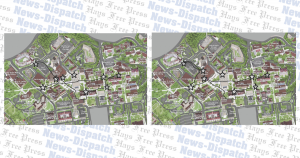
Contact tracing, a method that helps track and control the spread of infection, is slipping out of Hays County’s grip. With new cases spiking, limited testing, people not participating in contact tracing and backed up labs, the coronavirus is rapidly spreading.
The Hays County Health Department said it does contact tracing through crowd sourcing, which is when an individual is asked to inform people they have been in contact with that they tested positive. The county also calls residents to...
Contact tracing, a method that helps track and control the spread of infection, is slipping out of Hays County’s grip. With new cases spiking, limited testing, people not participating in contact tracing and backed up labs, the coronavirus is rapidly spreading.
The Hays County Health Department said it does contact tracing through crowd sourcing, which is when an individual is asked to inform people they have been in contact with that they tested positive. The county also calls residents to collect information for contact tracing. Resources are limited and not every testing site adheres to contact tracing. It is not a straightforward practice, given that there are two entities, state and local, who do the testing, and that test results are not coming back in a timely manner.
Tammy Crumley, director of countywide operations, said that individuals who get a coronavirus test through the National Guard and not at a clinic in Hays County, will not get a call about contact tracing. So far, thousands of tests in Hays County were administered through the National Guard.
Phone calls are not the only issue standing in the county’s way when it comes to contact tracing.
The county Health Department only has two epidemiologists on staff and three or four individuals who input the data to the Department of State Health Services in order for people to get the contact tracing call, explained Crumley.
When individuals get the call, there is no guarantee that contact tracing will be effective. Some people do not answer their phone when a tracer calls and they never call back, and some people give contact tracers wrong information to begin with.
“I think if individuals took responsibility and participated in crowd sourcing,” Crumley said, “then contact tracing would continue in aiding to stop the spread. But there’s a stigma of ‘oh don’t talk about so and so having it, because it’s a medical issue.’ But if we shared that information, we might get somewhere.”
When large numbers of contact tracing go undone, in a sense, it may become ineffective, Crumley said.
Another issue stands in the face of contact tracing, and that is test result time. Alex Villalobos, the county’s chief of staff, said that right now COVID-19 PCR (nasal swab) test results are taking between two to 14 days because labs are inundated. Tests given by local clinics are taking less time, while those going to state labs are taking longer because they see thousands of tests a day.
To combat the slowed testing, Villalobos said the county is adding more staff members and increasing test equipment.
Last week, the county stopped testing, but sites will be up through July 16, seeing 500 patients per day.
Even if testing is slow, Villalobos believes a major benefit from it is getting a census on community spread and hotspots. Once the county knows which communities are seeing extreme infections, it will better understand how to address the situation.
Since Hays County’s large spike in late June, cases are beginning to decrease, but there are several reasons that might affect the numbers. For example, according to data recorded on the Hays County COVID-19 webpage, the county had 210 new COVID-19 cases on June 18, and 92 new cases on July 10.
Several factors could explain why these numbers have gone down, Crumley said. It could be because the county and state government enacted policies requiring people to wear masks in public, shut down bars, tubing outfitters and more. But the other factor is that labs are backed up and testing has decreased.
Crumley said it would be difficult to come to a conclusion now on the direction of infection rates and whether the number of those infected has actually gone down.
“Everyone wants more testing and now we got it,” Crumley told Barton Publications. “Now what will we do, our lab is backed up. That’s why you hear people in the medical profession say we don’t need to get that many tests; instead go home and quarantine.”
At the end of the day, Crumley added, we do not have vaccines or treatment and that is why she does not see the point of administering an influx of tests. Data gathered will eventually be helpful, Crumley said, but right now it is only showing us who is testing positive and negative.
The best defense we have against the virus, for the time being, is following guidelines that ask people to stay home when they can, wear a mask in public, frequent handwashing and social distancing. Government efforts may also be another piece to slowing the spread.
“I think with restrictions back in place, we will start seeing a slowdown,” Crumley said.












